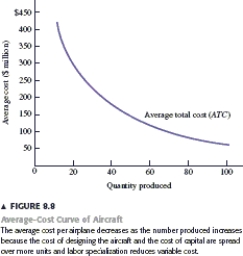Additional Application
THE AVERAGE COST OF PRODUCING AIRPLANES
Suppose you want to design and manufacture a new airplane, one with a performance level comparable to the Boeing 737. To get a rough idea of how much it would cost to design the new aircraft and then produce a particular quantity of airplanes, you could use the Airframe Cost Model developed by U.S. National Aeronautics and Space Administration NASA) . Figure 8.8 shows the average cost of production for up to 100 airplanes. The fixed cost includes the cost of designing the aircraft and the cost of capital used in the production process, including the machine tools used to fabricate the components of the aircraft. Together these fixed costs add up to about $2.45 billion. The variable cost includes the costs of the materials and labor used to produce the components and then assemble the aircraft. The NASA cost model suggests that the average variable cost decreases as the number of airplanes increases because of labor specialization. The average- cost curve in Figure 8.8 is negatively sloped because as the quantity of aircraft increases, the fixed cost is spread over more units and labor specialization pulls down the average variable cost. The average cost decreases from $435 million for a quantity of 10 aircraft, to $257 for 20 aircraft, and so on down to $86 million for 100 aircraft.
 The average-cost curve is negatively sloped, implying that there are no diminishing returns in the production of airplanes. This occurs because the cost model assumes that as output increases, production occurs over a longer period of time. Diminishing returns normally occur if an increase in output requires an increase in the number of workers in a given production facility. In the normal case, each worker becomes less productive because each worker gets a smaller share of the production facility-plant and equipment such as machine tools. But if doubling output means that we operate a given production facility twice as long, diminishing returns wonʹt occur: Each worker still gets the same share of the facility, but simply uses the facility for twice as much time.
The average-cost curve is negatively sloped, implying that there are no diminishing returns in the production of airplanes. This occurs because the cost model assumes that as output increases, production occurs over a longer period of time. Diminishing returns normally occur if an increase in output requires an increase in the number of workers in a given production facility. In the normal case, each worker becomes less productive because each worker gets a smaller share of the production facility-plant and equipment such as machine tools. But if doubling output means that we operate a given production facility twice as long, diminishing returns wonʹt occur: Each worker still gets the same share of the facility, but simply uses the facility for twice as much time.
-Recall the Application on ʺThe Average Cost of Producing Airplanes.ʺ The costs of labor and materials used to produce the components and then assemble the aircraft are:
Definitions:
External Locus
A belief that one's life events are largely influenced by external forces or the environment rather than by one's own efforts or attributes.
Attitude-Improving Feedback
Constructive criticism or suggestions provided with the intention of positively influencing someone's mindset or behavior.
Self-Absorbed
Preoccupied with one's own feelings, interests, or situations to the extent of overlooking the needs and concerns of others.
External Locus
The belief that one's outcomes in life are determined by external forces or environment rather than personal actions.
Q9: Refer to Figure 7.4. The deadweight loss
Q11: Which of the following is NOT a
Q21: The price elasticity of demand is calculated
Q59: If the quantity supplied is perfectly inelastic
Q71: The price elasticity of demand for color
Q155: In the short run, _ factors of
Q173: Recall the Application. If the price of
Q178: Recall the Application. When a patent ends
Q212: In short-run equilibrium for a competitive firm:<br>A)price
Q315: If profits in a monopolistically competitive market